Gothic Painting From Sister Wendy Becket,

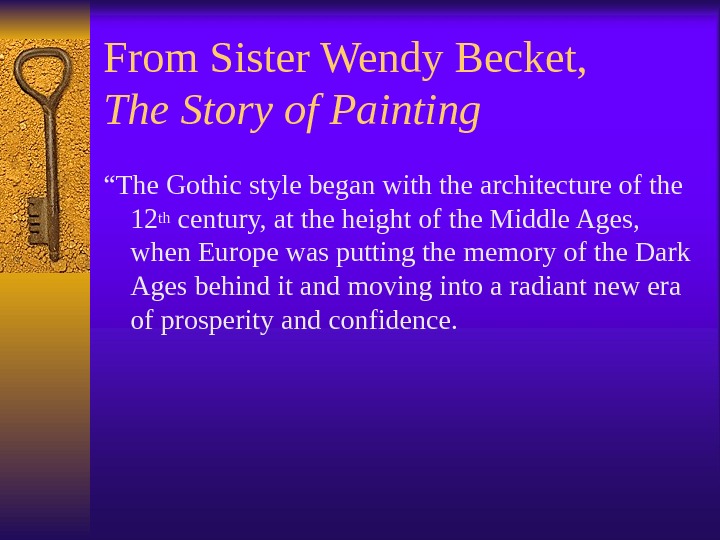
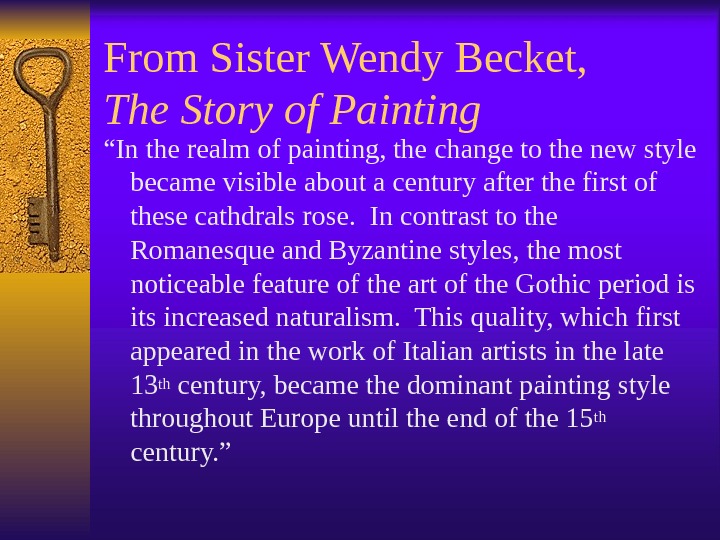
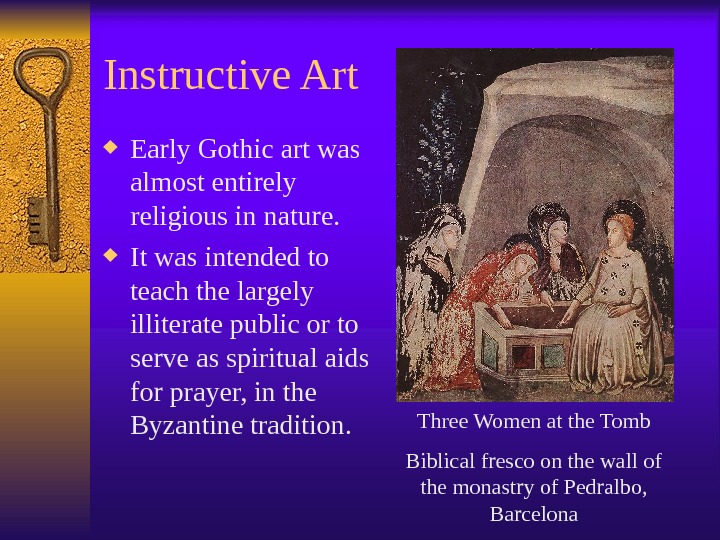
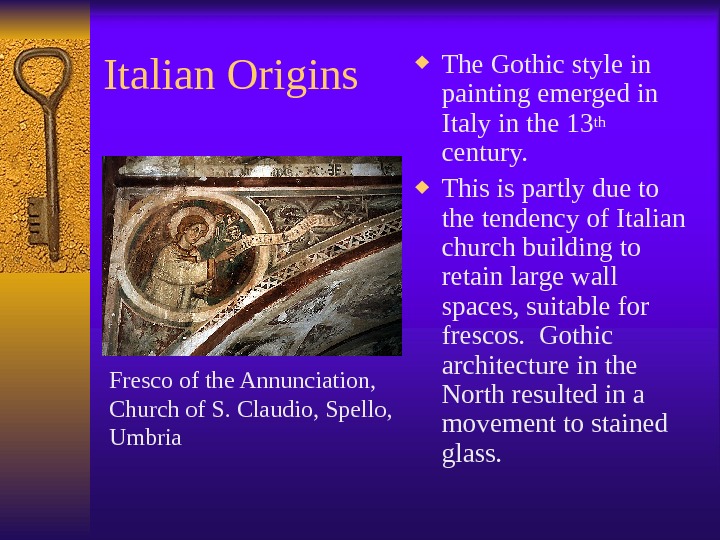
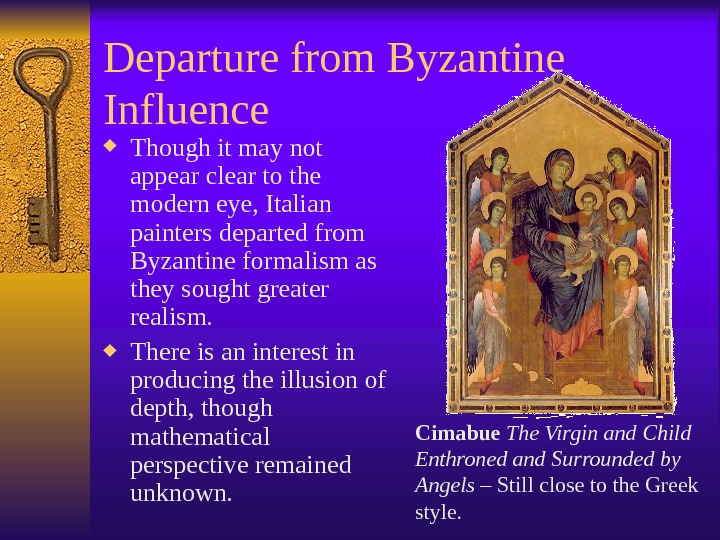
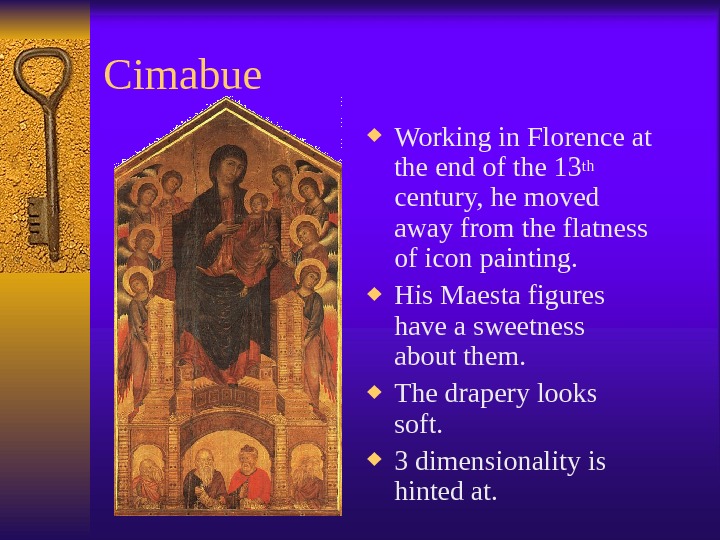

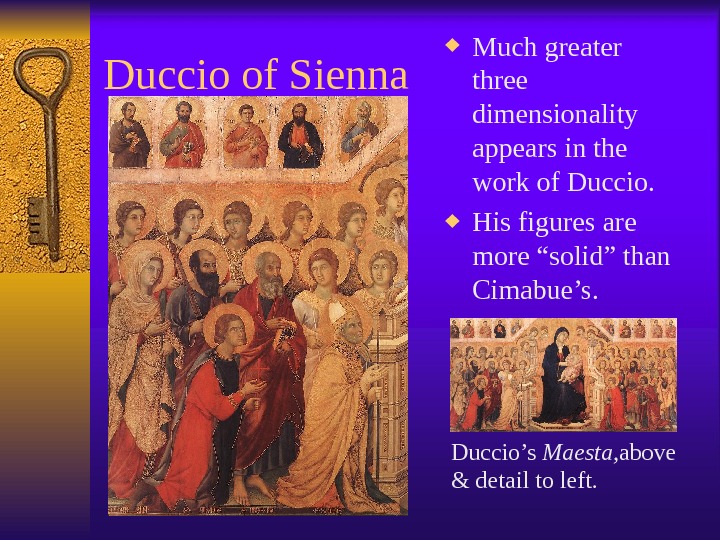


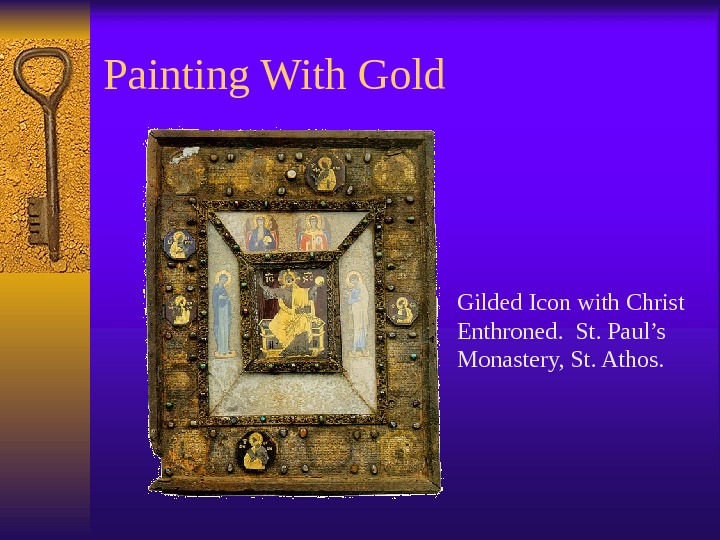
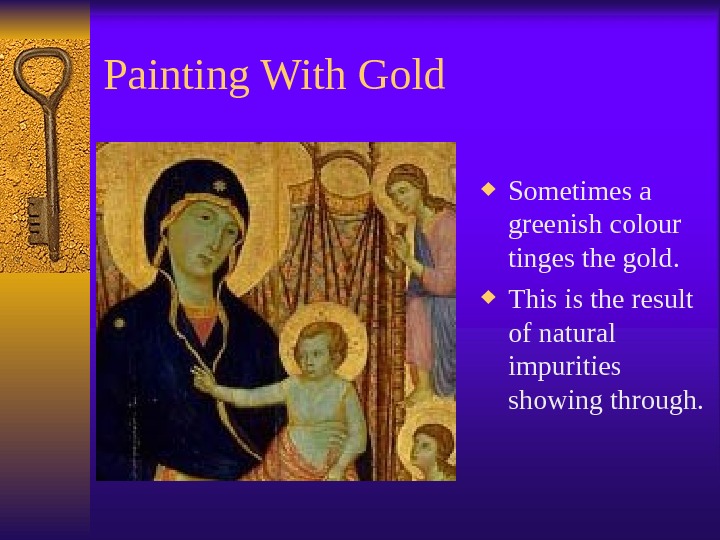
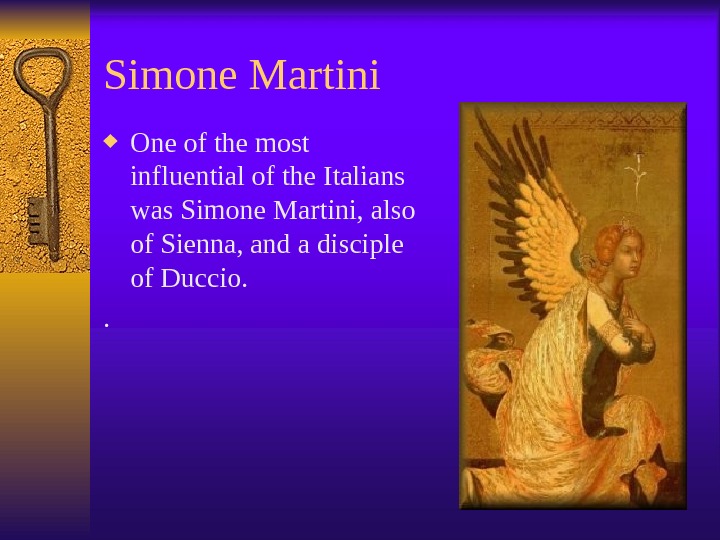


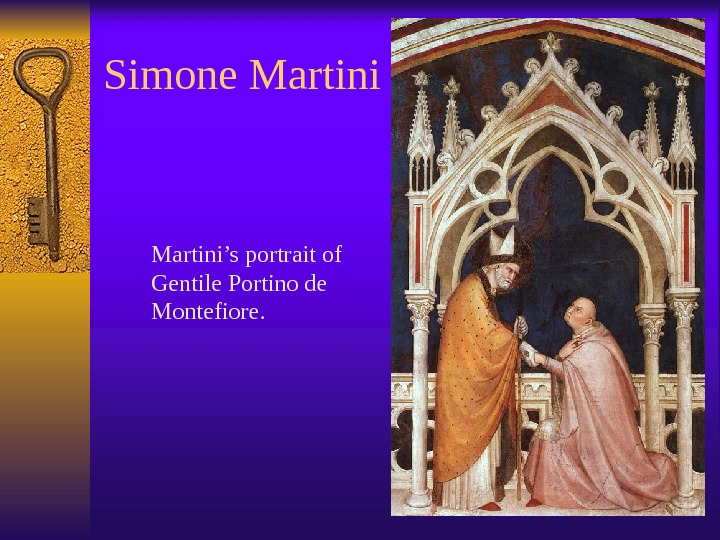
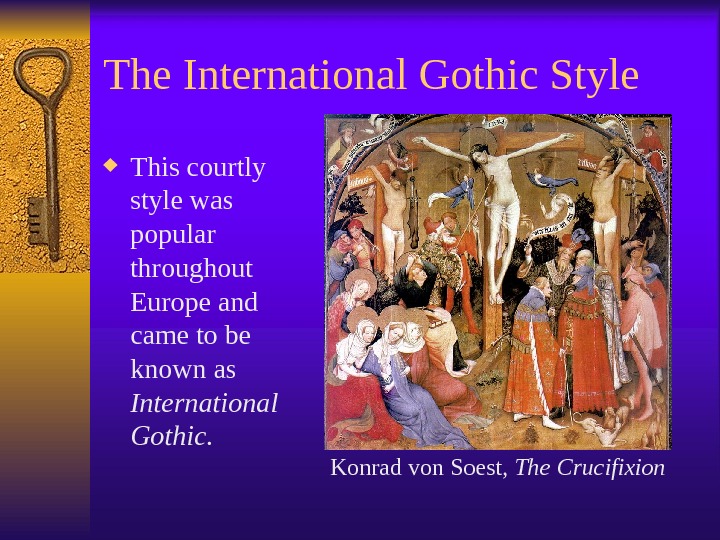
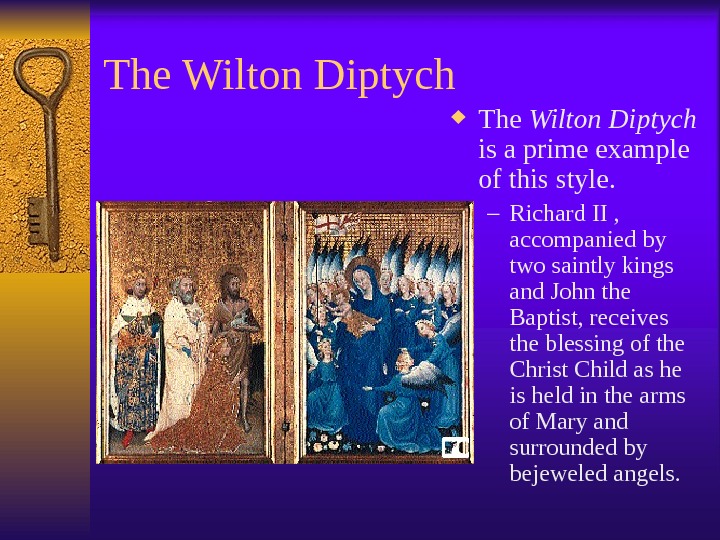
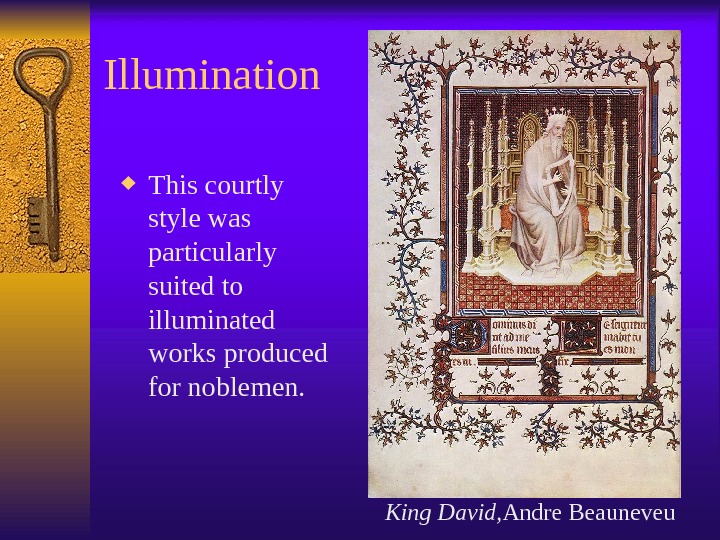
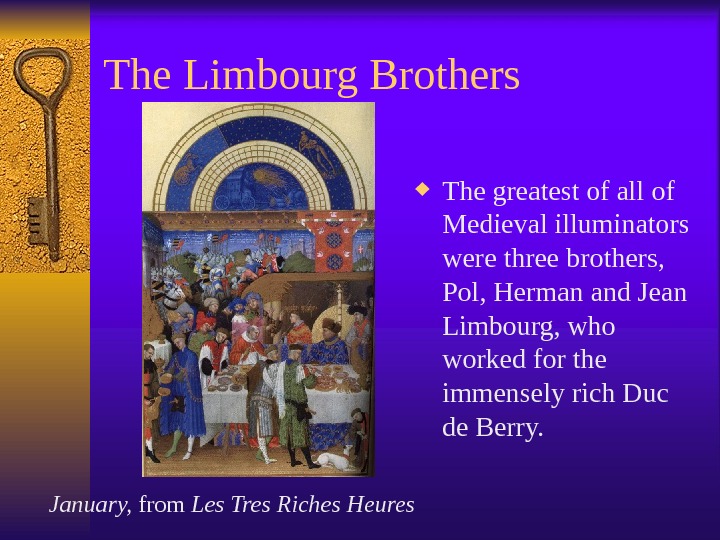

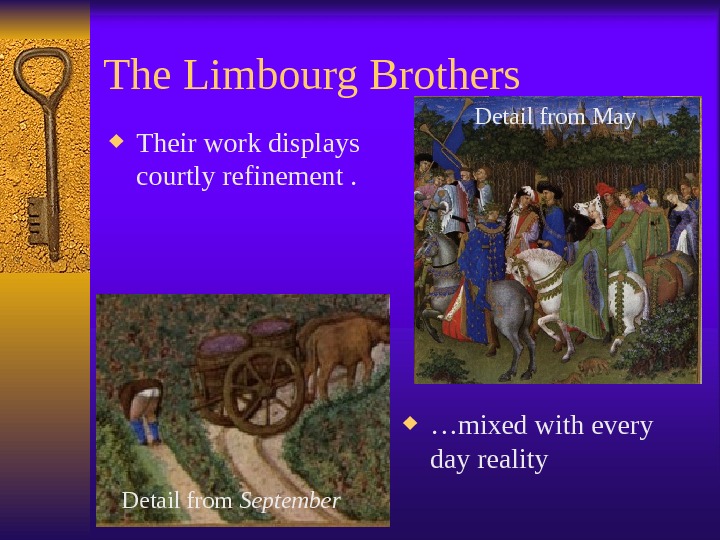
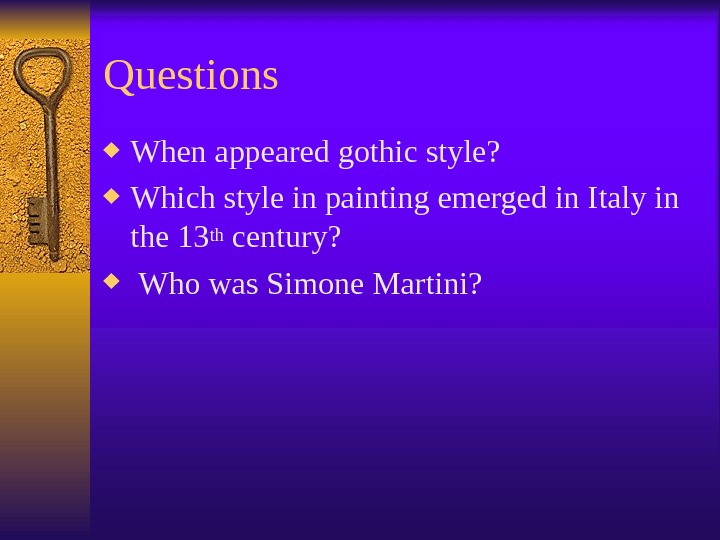
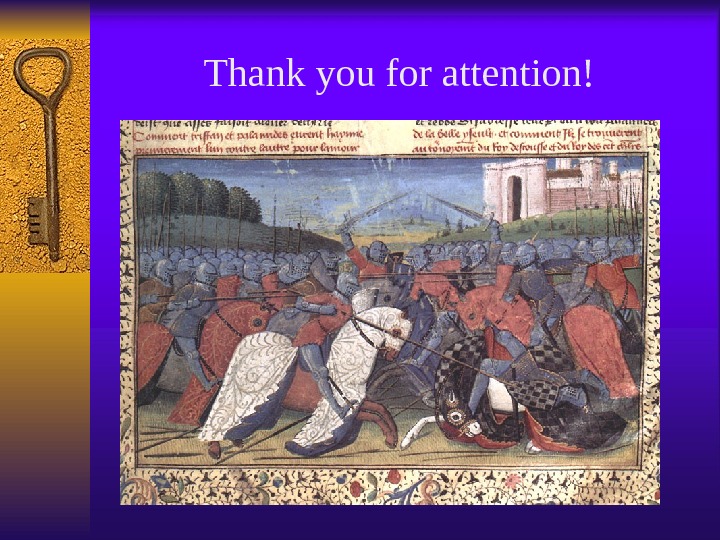
- Размер: 5.1 Mегабайта
- Количество слайдов: 25
Описание презентации Gothic Painting From Sister Wendy Becket, по слайдам
 Gothic Painting
Gothic Painting
 From Sister Wendy Becket, The Story of Painting “ The Gothic style began with the architecture of the 12 th century, at the height of the Middle Ages, when Europe was putting the memory of the Dark Ages behind it and moving into a radiant new era of prosperity and confidence.
From Sister Wendy Becket, The Story of Painting “ The Gothic style began with the architecture of the 12 th century, at the height of the Middle Ages, when Europe was putting the memory of the Dark Ages behind it and moving into a radiant new era of prosperity and confidence.
 From Sister Wendy Becket, The Story of Painting “ In the realm of painting, the change to the new style became visible about a century after the first of these cathdrals rose. In contrast to the Romanesque and Byzantine styles, the most noticeable feature of the art of the Gothic period is its increased naturalism. This quality, which first appeared in the work of Italian artists in the late 13 th century, became the dominant painting style throughout Europe until the end of the 15 th century. ”
From Sister Wendy Becket, The Story of Painting “ In the realm of painting, the change to the new style became visible about a century after the first of these cathdrals rose. In contrast to the Romanesque and Byzantine styles, the most noticeable feature of the art of the Gothic period is its increased naturalism. This quality, which first appeared in the work of Italian artists in the late 13 th century, became the dominant painting style throughout Europe until the end of the 15 th century. ”
 Instructive Art Early Gothic art was almost entirely religious in nature. It was intended to teach the largely illiterate public or to serve as spiritual aids for prayer, in the Byzantine tradition. Three Women at the Tomb Biblical fresco on the wall of the monastry of Pedralbo, Barcelona
Instructive Art Early Gothic art was almost entirely religious in nature. It was intended to teach the largely illiterate public or to serve as spiritual aids for prayer, in the Byzantine tradition. Three Women at the Tomb Biblical fresco on the wall of the monastry of Pedralbo, Barcelona
 Italian Origins The Gothic style in painting emerged in Italy in the 13 th century. This is partly due to the tendency of Italian church building to retain large wall spaces, suitable for frescos. Gothic architecture in the North resulted in a movement to stained glass. Fresco of the Annunciation, Church of S. Claudio, Spello, Umbria
Italian Origins The Gothic style in painting emerged in Italy in the 13 th century. This is partly due to the tendency of Italian church building to retain large wall spaces, suitable for frescos. Gothic architecture in the North resulted in a movement to stained glass. Fresco of the Annunciation, Church of S. Claudio, Spello, Umbria
 Departure from Byzantine Influence Though it may not appear clear to the modern eye, Italian painters departed from Byzantine formalism as they sought greater realism. There is an interest in producing the illusion of depth, though mathematical perspective remained unknown. Cimabue The Virgin and Child Enthroned and Surrounded by Angels – Still close to the Greek style.
Departure from Byzantine Influence Though it may not appear clear to the modern eye, Italian painters departed from Byzantine formalism as they sought greater realism. There is an interest in producing the illusion of depth, though mathematical perspective remained unknown. Cimabue The Virgin and Child Enthroned and Surrounded by Angels – Still close to the Greek style.
 Cimabue Working in Florence at the end of the 13 th century, he moved away from the flatness of icon painting. His Maesta figures have a sweetness about them. The drapery looks soft. 3 dimensionality is hinted at.
Cimabue Working in Florence at the end of the 13 th century, he moved away from the flatness of icon painting. His Maesta figures have a sweetness about them. The drapery looks soft. 3 dimensionality is hinted at.
 Cimabue Angels, detail from Cimabue’s fresco Apocalyptical Christ, found in the upper church of San Francesco, Assisi.
Cimabue Angels, detail from Cimabue’s fresco Apocalyptical Christ, found in the upper church of San Francesco, Assisi.
 Duccio of Sienna Much greater three dimensionality appears in the work of Duccio. His figures are more “solid” than Cimabue’s. Duccio’s Maesta, above & detail to left.
Duccio of Sienna Much greater three dimensionality appears in the work of Duccio. His figures are more “solid” than Cimabue’s. Duccio’s Maesta, above & detail to left.
 Painting with Gold This most valuable metal has always been reserved for the most important works – in sculpture, painting, or architectural detailing.
Painting with Gold This most valuable metal has always been reserved for the most important works – in sculpture, painting, or architectural detailing.
 Painting with gold In Byzantine and Medieval painting, gold was used to indicate the spiritual or heavenly sphere. Its reflective properties are superbly suited to candle-lit illumination. A modern gilded icon in the Byzantine tradition
Painting with gold In Byzantine and Medieval painting, gold was used to indicate the spiritual or heavenly sphere. Its reflective properties are superbly suited to candle-lit illumination. A modern gilded icon in the Byzantine tradition
 Painting With Gold Gilded Icon with Christ Enthroned. St. Paul’s Monastery, St. Athos.
Painting With Gold Gilded Icon with Christ Enthroned. St. Paul’s Monastery, St. Athos.
 Painting With Gold Sometimes a greenish colour tinges the gold. This is the result of natural impurities showing through.
Painting With Gold Sometimes a greenish colour tinges the gold. This is the result of natural impurities showing through.
 Simone Martini One of the most influential of the Italians was Simone Martini, also of Sienna, and a disciple of Duccio. .
Simone Martini One of the most influential of the Italians was Simone Martini, also of Sienna, and a disciple of Duccio. .
 Simone Martini At the end of his life, Martini resided in Avignon, the temporary residence of popes. This brought his style to the attention of the French.
Simone Martini At the end of his life, Martini resided in Avignon, the temporary residence of popes. This brought his style to the attention of the French.
 Simone Martini’s colours and architectural backgrounds are in the manner of Duccio. His modeling of people, however, is in the more radical style of Giotto.
Simone Martini’s colours and architectural backgrounds are in the manner of Duccio. His modeling of people, however, is in the more radical style of Giotto.
 Simone Martini’s portrait of Gentile Portino de Montefiore.
Simone Martini’s portrait of Gentile Portino de Montefiore.
 The International Gothic Style This courtly style was popular throughout Europe and came to be known as International Gothic. Konrad von Soest, The Crucifixion
The International Gothic Style This courtly style was popular throughout Europe and came to be known as International Gothic. Konrad von Soest, The Crucifixion
 The Wilton Diptych is a prime example of this style. – Richard II , accompanied by two saintly kings and John the Baptist, receives the blessing of the Christ Child as he is held in the arms of Mary and surrounded by bejeweled angels.
The Wilton Diptych is a prime example of this style. – Richard II , accompanied by two saintly kings and John the Baptist, receives the blessing of the Christ Child as he is held in the arms of Mary and surrounded by bejeweled angels.
 Illumination This courtly style was particularly suited to illuminated works produced for noblemen. King David, Andre Beauneveu
Illumination This courtly style was particularly suited to illuminated works produced for noblemen. King David, Andre Beauneveu
 The Limbourg Brothers The greatest of all of Medieval illuminators were three brothers, Pol, Herman and Jean Limbourg, who worked for the immensely rich Duc de Berry. January, from Les Tres Riches Heures
The Limbourg Brothers The greatest of all of Medieval illuminators were three brothers, Pol, Herman and Jean Limbourg, who worked for the immensely rich Duc de Berry. January, from Les Tres Riches Heures
 The Limbourg Brothers Historians have found this volume a particularly rich source of information on the lives of rich and poor in early 15 th century France. February
The Limbourg Brothers Historians have found this volume a particularly rich source of information on the lives of rich and poor in early 15 th century France. February
 The Limbourg Brothers Their work displays courtly refinement. … mixed with every day reality Detail from May Detail from September
The Limbourg Brothers Their work displays courtly refinement. … mixed with every day reality Detail from May Detail from September
 Questions When appeared gothic style? Which style in painting emerged in Italy in the 13 th century? Who was Simone Martini?
Questions When appeared gothic style? Which style in painting emerged in Italy in the 13 th century? Who was Simone Martini?
 Thank you for attention!
Thank you for attention!
